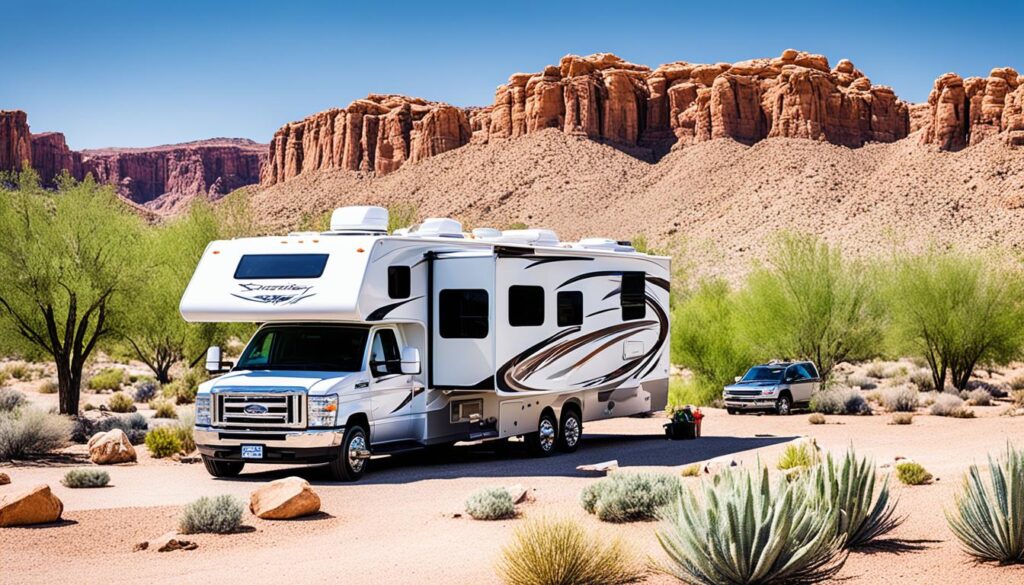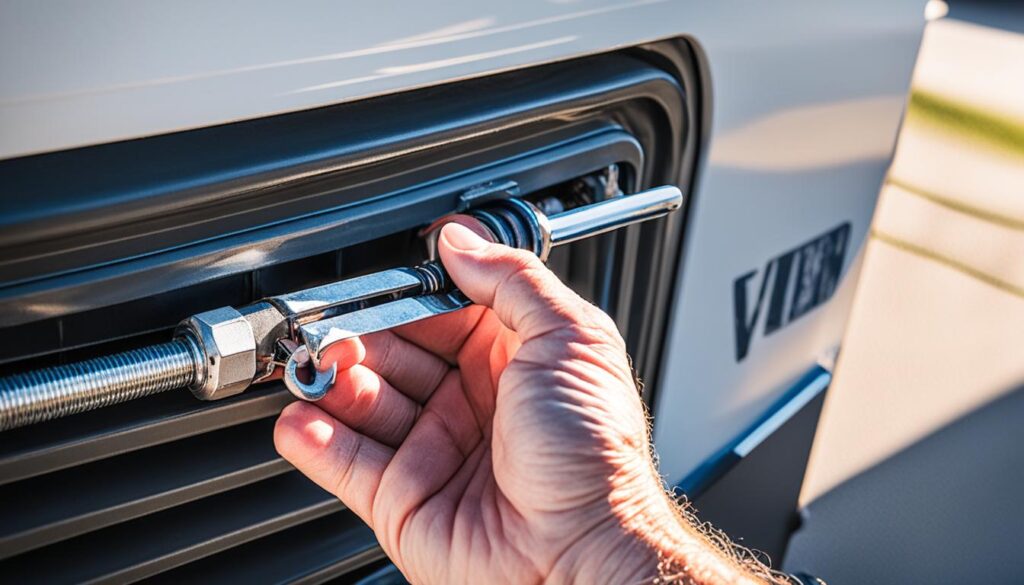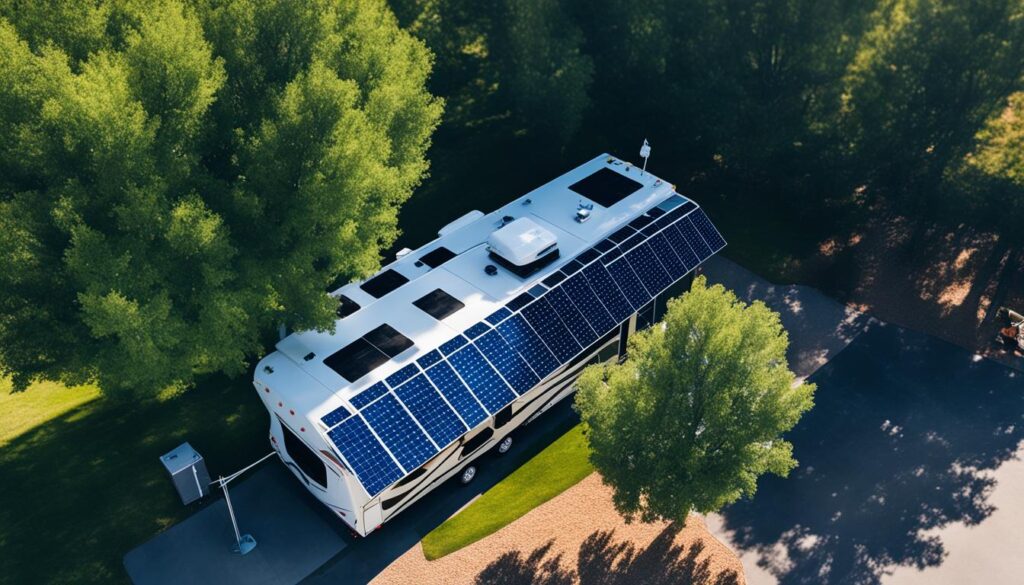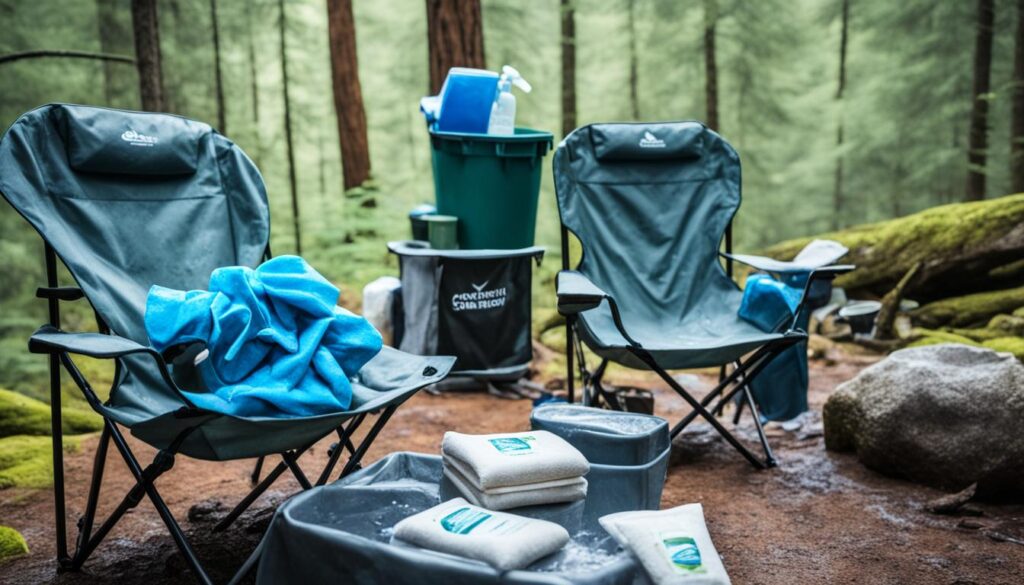Is the scorching summer heat making your RV feel like an oven? Don’t let the rising temperatures dampen your travel plans. Discover effective strategies and techniques to keep your RV cool and comfortable during those hot summer months. From utilizing shade to creating airflow, we’ll explore the best ways to beat the heat and create a cooler environment inside your RV.
So, how can you make your RV a cool oasis amidst the blazing heat? Let’s dive in and find out.
Key Takeaways:
- Park your RV in the shade to minimize heat buildup.
- Create shade around your RV using awnings or tarps.
- Maximize airflow inside your RV by taking advantage of wind patterns and using fans.
- Protect your windows with insulated covers or reflective insulation.
- Maintain your cooling system through regular cleaning and maintenance tasks.
One of the easiest ways to keep your RV cool is by parking it in the shade. When selecting a campsite, look for areas with natural shade from trees or buildings. Position your RV so that it is shaded during the hottest part of the day, particularly in the afternoon when temperatures are at their highest. This will help prevent your RV from becoming excessively hot and reduce the reliance on your cooling system.
Create Shade
When it comes to keeping your RV cool, parking in the shade is just the beginning. In addition, you can take proactive steps to create shade around your RV, further enhancing its cooling capabilities.
One of the easiest ways to create shade is by utilizing your RV’s awning. Make sure to keep it down during the day to provide a shaded area outside your RV. Not only does this help block out direct sunlight, but it also prevents the heat from penetrating the interior of your RV.
But what if there are no nearby trees to provide natural shade? Don’t worry, there’s a simple solution. You can create a shaded area by tying a large tarp to your RV and securing it to the ground with stakes. This makeshift shade structure will help keep the sun at bay and maintain a cooler environment inside your RV.
By creating shade around your RV, you can effectively reduce the amount of direct sunlight that reaches the vehicle, keeping it cooler and more comfortable for you and your fellow travelers.
With these RV cooler hacks and shade-creating techniques, you’ll be well-equipped to beat the heat and enjoy a cool and comfortable travel experience.
Go With the Flow
Creating airflow inside your RV is essential for maintaining a cooler temperature. By implementing a few RV cooler modifications, you can maximize airflow and create a more comfortable environment.
To begin, orient your RV with the breeze by positioning it to take advantage of wind patterns. This will allow natural air movement to cool down the interior of your RV. Consider factors such as the direction of prevailing winds and the placement of surrounding obstacles. By strategically positioning your RV, you can optimize airflow and dissipate heat effectively.
Keeping windows open is another way to encourage airflow and create a cross-ventilation system inside your RV. However, to prevent dust and bugs from entering, use screens on the windows. Screens will allow fresh air to circulate while keeping unwanted elements out.
“Creating airflow inside your RV is essential for maintaining a cooler temperature.”
Portable fans can also be employed to improve airflow. By placing fans strategically inside your RV, you can move warm air and create a pleasant breeze. Battery-powered or rechargeable fans are ideal for RVs, as they do not require a constant power source and can be easily positioned wherever necessary.
Benefits of Creating Airflow in Your RV
Enhancing airflow in your RV offers several advantages:
- Improved comfort: Proper airflow prevents air stagnation and reduces hotspots, keeping you cool and comfortable.
- Reduced reliance on cooling systems: With effective airflow, you can rely less on air conditioners or other cooling systems, resulting in reduced energy consumption and cost savings.
- Healthy environment: Fresh air circulation helps remove odors, moisture, and improves indoor air quality, contributing to a healthier living space.
- Condensation prevention: Adequate airflow helps minimize condensation buildup, preventing issues like mold and mildew.
Incorporating these RV cooler modifications and creating airflow will significantly enhance your RV’s cooling capabilities. By maximizing natural air movement, utilizing windows and screens, and strategically placing portable fans, you can maintain a comfortable, cooler environment inside your RV even during hot summer days.
Need more cool air? Maybe it’s time to consider a swamp cooler, also known as an evaporative cooler.
Example Table: Comparison of RV Cooler Modification Methods
| RV Cooler Modifications | Effectiveness | Complexity | Cost | Recommended for |
|---|---|---|---|---|
| Parking in the shade | High | Low | Free | All RV owners |
| Creating shade | Moderate | Low | Low – Moderate | RV owners without access to natural shade |
| Maximizing airflow | High | Low | Low – Moderate | All RV owners |
(Note: This is a simplified example table for demonstration purposes only. In a real article, the table would contain comprehensive data and analysis.)

Protect Your Windows
Windows play a significant role in regulating the temperature inside your RV. To keep the interior cooler, it’s essential to take measures to minimize heat entering through the windows.
One effective method is to use insulated window covers or curtains that can block out the heat and sunlight. These window treatments provide an extra layer of insulation and help maintain a cooler environment within your RV.
Another valuable option is to utilize reflective insulation on your windows. Reflective insulation is designed to reflect the sun’s rays, reducing heat transfer and preventing it from entering your RV. You can find reflective insulation products at most home improvement stores.
By combining insulated window covers or curtains with reflective insulation, you can significantly reduce the amount of heat that enters your RV through the windows. This proactive approach to window protection will help keep your RV cooler and more comfortable during hot summer days.
Keep Your Cooling System Efficient
Properly maintaining your RV’s cooling system is crucial for optimal performance and cooling efficiency. To ensure that your cooling system keeps your RV cool throughout your travels, follow these key maintenance tips:
- Clean and Replace Air Filters: Regularly clean and replace the air filters in your RV’s cooling system. This helps to prevent dust and debris from clogging the filters and ensures that the unit can efficiently circulate cool air.
- Inspect and Clean the Fridge Vent: The fridge vent in your RV plays a significant role in dissipating heat. Inspect the vent regularly and remove any dirt or debris that may be blocking the airflow. Keeping the vent clean promotes proper heat transfer, allowing your fridge to function optimally.
- Use Energy-Efficient LED Lights: LED lights produce significantly less heat compared to traditional incandescent bulbs. By using energy-efficient LED lights inside your RV, you can reduce the heat output and minimize the strain on your cooling system.
By following these maintenance practices, you can ensure that your RV’s cooling system operates at its best, providing you with a consistently cool and comfortable living environment.

| Maintenance Tips | Benefits |
|---|---|
| Clean and replace air filters | Optimal performance and air circulation |
| Inspect and clean the fridge vent | Prevents heat buildup and improves fridge efficiency |
| Use energy-efficient LED lights | Reduced heat output and lower strain on cooling system |
Cook Al Fresco
Cooking indoors can generate additional heat inside your RV. To prevent this, consider cooking outdoors on a grill or campfire instead. This will help to minimize the amount of heat being produced inside your RV and keep the interior cooler. Additionally, you can enjoy the experience of cooking al fresco and trying out fun camping recipes to enhance your summer travels.
When cooking outdoors, make sure to utilize the natural airflow and ventilation available. Choose recipes that require less cooking time or use ingredients that do not emit excessive heat. Opt for refreshing and light dishes that are perfect for outdoor dining.
Here are some popular outdoor cooking methods and ideas for your homemade RV cooler:
- Grilling: Nothing beats the smoky flavors of grilled meats, fish, and vegetables. Set up a portable grill outside your RV and enjoy the delicious aromas and flavors that grilling brings.
- Campfire Cooking: Embrace the traditional method of campfire cooking by roasting marshmallows, making s’mores, or preparing foil packets filled with seasoned meats and vegetables. The crackling fire and the ambiance of the outdoors will enhance your dining experience.
- One-Pot Meals: Prepare easy one-pot meals that require minimal cleanup and use a single cooking vessel. Whether it’s a hearty soup, a flavorful stir-fry, or a comforting pasta dish, one-pot meals are convenient and perfect for outdoor cooking.
- Skewers and Kabobs: Thread your favorite meats, vegetables, and fruits onto skewers or metal kabob sticks for a customizable and easy-to-cook meal. Grill or broil them for delicious and vibrant skewers bursting with flavor.
Outdoor cooking not only keeps your RV cooler, but it also adds excitement and adventure to your camping experience. Experiment with different cooking methods, try new recipes, and embrace the joy of cooking amidst nature.
Conclusion
Keeping your RV cool during the summer is essential for a comfortable travel experience. By implementing strategies such as parking in the shade, creating shade, maximizing airflow, insulating your RV, and properly maintaining your cooling system, you can effectively beat the heat and stay cool.
In addition to these strategies, there are a couple of final tips that can further enhance your cooling efforts. Consider investing in a portable RV cooler, which can provide additional cooling power and flexibility. These coolers are compact, lightweight, and can be easily moved to different areas of your RV as needed.
Furthermore, pay attention to the small details that can contribute to a cooler RV interior. Utilize energy-efficient options like LED lights, which produce less heat than traditional bulbs. Additionally, take advantage of outdoor cooking opportunities to minimize the heat generated inside your RV.
With these final tips and tricks, you can enjoy a comfortable retreat from the summer heat during your RV travels. Stay cool and make the most of your outdoor adventures!
FAQ
How can I keep my RV cooler in the summer?
There are several strategies you can use to keep your RV cooler in the summer. These include parking in the shade, creating shade around your RV, creating airflow inside your RV, protecting your windows with insulated covers, maintaining your cooling system, cooking outdoors, and using energy-efficient LED lights. By implementing these tips and tricks, you can effectively beat the heat and enjoy a cooler RV interior.
How can I park in the shade?
When selecting a campsite, look for areas with natural shade from trees or buildings and try to position your RV so that it is shaded during the hottest part of the day, especially in the afternoon. This will help prevent your RV from becoming excessively hot and reduce the reliance on your cooling system.
How can I create shade around my RV?
You can create shade around your RV by utilizing your RV’s awning and keeping it down during the day to provide shade. If there are no nearby trees, you can also tie a large tarp to your RV and secure it to the ground with stakes to create a shaded area.
How can I create airflow inside my RV?
To create airflow inside your RV, orient it with the breeze by positioning it to take advantage of wind patterns. Keep windows open and use screens to keep out dust and bugs while allowing fresh air to circulate. Additionally, using portable fans can help move warm air and create a breeze inside the RV.
How can I protect my windows from heat entering my RV?
You can protect your windows from heat entering your RV by using insulated window covers or curtains to block out the heat. Reflective insulation applied to the windows can also help reflect the sun’s rays and prevent heat from entering.
How can I keep my cooling system efficient?
To keep your cooling system efficient, regularly clean and replace air filters to ensure optimal performance. Inspect and clean the fridge vent to prevent heat buildup. Using energy-efficient LED lights inside your RV can also help reduce heat output.
How can I cook al fresco to keep my RV cooler?
Cooking outdoors on a grill or campfire instead of indoors can help minimize the amount of heat being produced inside your RV and keep the interior cooler. Additionally, it allows you to enjoy the experience of cooking al fresco and trying out fun camping recipes.
What are some final tips for keeping my RV cool?
In addition to the strategies mentioned above, consider insulating your RV and using reflective materials on the roof to reduce heat absorption. Installing window tinting can also help block out heat. Using awnings or reflective covers on the exterior of your RV can further decrease its exposure to direct sunlight. Lastly, parking strategically with consideration of wind patterns can naturally cool your RV.






